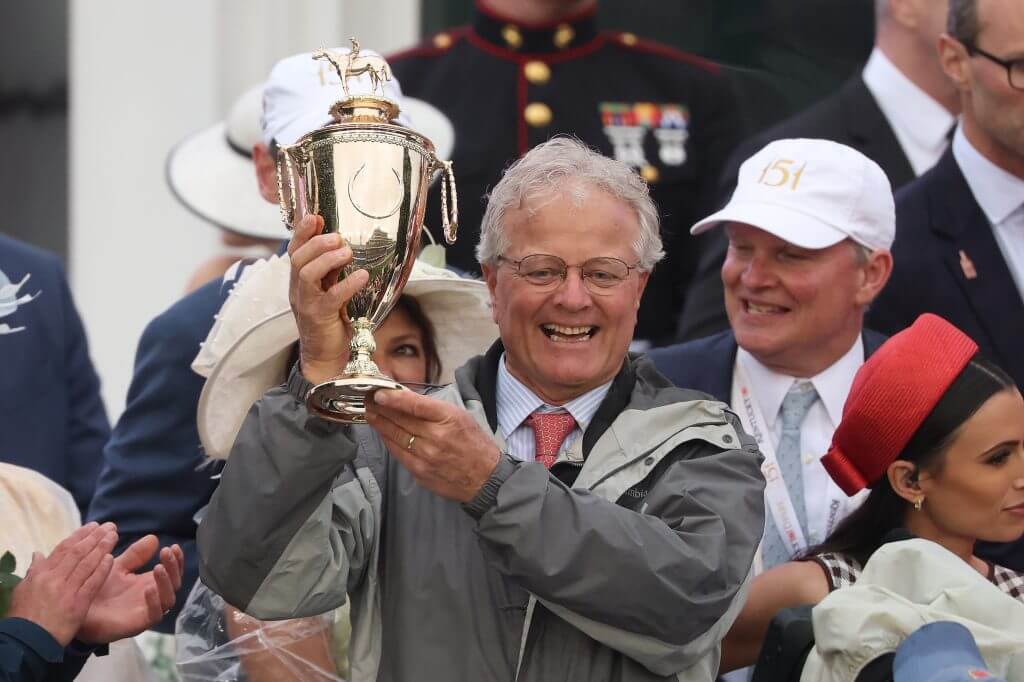
With a quick phone call to Mike Rogers, the executive vice president of 1/ST, which operates Pimlico racetrack, horse trainer Bill Mott on Tuesday effectively ended the casual fan’s interest in horse racing for 2025. Mott told Rogers that Sovereignty, who only three days earlier had won the Kentucky Derby by roaring past favorite Journalism in the stretch, will not run in the Preakness Stakes and will instead point toward the Belmont Stakes on June 7. Not only will there be no Triple Crown winner for the seventh year in a row, but for the third time in those seven years, no one will even make the attempt.
Advertisement
Mott, a Hall of Fame trainer considered a thoughtful and honorable horseman by his peers, was both entirely within his rights to decline to race in the Preakness and doing what he believes is best by his horse. Trainers meticulously check their horses post-race, making sure they emerge uninjured, are eating properly and seem generally content. They also take into consideration the wear and tear of the previous race — in Sovereignty’s case, an arduous, 19-horse field in the mud — and plot the best course of action for future success. The general public might crave Sovereignty’s entry into the Preakness, but if Mott doesn’t think it’s the best race for his horse, then that’s that, fan interest be darned.
“It is not a simple decision. Not at all,” says trainer Michael McCarthy, who is wrestling with a similar choice regarding Journalism. “It’s easy to say the sporting thing is to run in the Preakness and go to try and win the Triple Crown, but there’s a lot more to it. The Triple Crown is very demanding. It’s not meant to be easy, which is why only a few elite horses have done it in modern times. I don’t know the reasons behind this decision, but I can tell you no one questions Bill Mott. It’s his horse and his decision.”
Nonetheless, Sovereignty’s removal from the Preakness field exposed the nerve that sits at the root of horse racing’s problem. The sport is trying desperately to get more people interested in it. Meanwhile, it is also focused on maintaining the safety and health of the horses, and some voices in the racing community believe running the three Triple Crown races in a span of five weeks is asking too much. The timing aspect complicates decision-making and impacts fan interest in what are the sport’s premier events.

After winning the Kentucky Derby, trainer Bill Mott decided not to race Sovereignty in the upcoming Preakness Stakes, forgoing a shot at the Triple Crown. (Michael Reaves / Getty Images)
Absent the ownership path for the affluent, the casual fan’s entry to horse racing excitement is the tried and true pairing of the Derby’s pageantry and the five-week pursuit of the Triple Crown. Before he owned horses himself, former Major League Baseball player Jayson Werth admitted his knowledge began and ended with those two things, but even that was enough to make him tune in to watch.
Advertisement
An estimated 17 million people watched the Saturday broadcast as Sovereignty ran through the slop to victory. History says those numbers won’t stack up on May 17 when the Preakness is run. Three years ago, when longshot Derby winner Rich Strike bowed out of the Preakness, only 5.2 million watched the Preakness broadcast compared to 16 million for the Derby that year.
Aside from interest in the Triple Crown pursuit, racing is exploring other ways to get viewers invested in the sport, in some cases literally. America’s Best Racing has an entire program, A Stake in Stardom, designed to bring younger people to the track via ownership. That’s how 26-year-old influencer Griffin Johnson became part of the ownership group for Kentucky Derby qualifier Sandman. Though the influencer-to-horse ratio is a bit disproportionate — 9.7 million TikTok followers to 2.5 percent of the horse — the partnership did its job. More than five million people clicked on Johnson’s post-race thank you video.
To typical fans who see only the singular pursuit of championships as sports’ endgame, Mott’s decision to sideline Sovereignty for the Preakness flies in the face of sports logic. To horsemen, it is the result of a collision course involving a calendar created for racehorses who are no longer built like they once were.
The Triple Crown calendar has changed over time, both in terms of the time between races and the order in which they are run. Gallant Fox started his Triple Crown quest in 1930 with the Preakness and then went on to the Derby. Five years later, Omaha won the races in the order we are familiar with today, but had just a week off between the Derby and the Preakness. The three tracks finally agreed on the current calendar — the Derby on the first Saturday in May, the Preakness two weeks later and the Belmont three weeks after that — in 1969.
But like pitchers who work with pitch counts in baseball and basketball players who are subject to load management, the horses today aren’t trained to race like they used to. In 1948, Citation not only won the Triple Crown; he ran in (and won) the Jersey Stakes in between the Preakness and the Belmont. The great Secretariat raced three weeks after “moving like a tremendous machine” to win the Belmont in 1973. He also ran 12 times before the Derby, including in the Wood Memorial two weeks prior to the Run for the Roses.
Advertisement
By comparison, Sovereignty raced a grand total of five times leading up to the Derby, and not since March 29th.
“The way horses are bred now, they’re just not quite as rugged,” McCarthy says. “They’re just not as sound as they were 40 or 50 years ago. It takes a special horse [to win the Triple Crown].”
Bob Baffert had two of those horses — American Pharoah, who won the Triple Crown in 2015, and Justify, who matched his efforts in 2018. But Baffert has never shied away from taking his Derby winner to Baltimore. All six of his Derby winners have come back to run in Baltimore, and five of his Derby winners went on to win the Preakness. The only one who didn’t, Authentic, lost in a photo finish in a post-pandemic season when the entire calendar had been upended.
Baffert admits he likes the vibe at the Preakness, where the pressure is off to win the Derby and not yet heaped on if you’re aiming for a Triple Crown. He’s also won it a record eight times. Even he says it requires a unique horse to pursue the feat.
“You have to have the horse,” Baffert says. “I mean, American Pharoah, man, he was just so rare.”
The condensed race schedule has long been the subject of many a barroom debate, especially through a 37-year Triple Crown drought that American Pharoah finally ended in 2015. The riddle boils down to this: Either the Triple Crown is too hard to win, and ergo the calendar should be altered; or winning the Triple Crown should be hard, and therefore the schedule ought to remain.
Race organizers have toyed with changing the schedule previously. Two years ago, Aidan Butler, then the chief executive for 1/ST Racing, told the Thoroughbred Daily News that his track was interested in moving the Preakness four weeks post-Derby. It certainly made sense for Pimlico, the track that plays host to the Preakness. No one skips the Derby; plenty of horses take the four-week rest and come back for the Belmont; the Preakness is the easiest to squeeze.
Advertisement
“This would give horses more time to recover between races to be able to run in the Preakness,” Butler said at the time. “Horse racing is more important than tradition. [The New York Racing Association] is aware and considering how this would impact the Belmont. Stay tuned.”
The “stay tuned” part didn’t take long. Shortly after Butler’s statement, the New York Racing Association (NYRA), which runs the Belmont, said through a spokesperson, “We have no plans to move the Belmont Stakes.”
Further complicating things, Fox cemented a nine-year deal in 2023 with NYRA, which makes the network the exclusive partner for not just the Belmont Stakes, but all other races at Belmont Park, Aqueduct and Saratoga. The Derby and Preakness remain on NBC. Adjusting the calendar now also requires both sets of TV execs to agree to the shift.
“The classics are still the classics. It’s the best 3-year-old horses,” Baffert says. “I know people are disappointed or whatever, but I also know Bill Mott would love to win a Triple Crown because every trainer wants to win a Triple Crown. But he knows his horse well, and we have to respect that.”
(Top Photo: Michael Reaves / Getty Images)
This news was originally published on this post .








Be the first to leave a comment